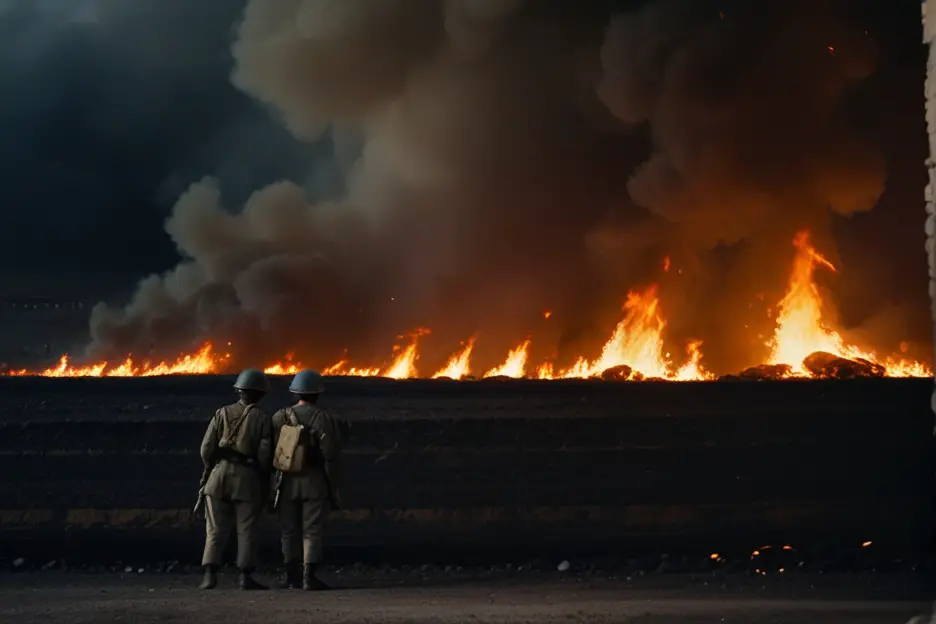
World War I and World War II are two of the most significant conflicts in human history.
Although they share some similarities, they also have distinct differences in terms of causes, major events, technological advancements, home fronts, and consequences.
In this blog post, we will compare and contrast these two wars, providing insights into their causes, key events, technological advancements, home fronts, and the end of the wars.
- Read also: What would happen if World War 3 broke out?
- Read also: Unveiling History: Civil War vs Revolutionary War
Causes of the Wars
World War I
Nationalism and imperialism
Intense nationalism and the quest for imperial dominance heightened tensions among European nations, sparking rivalries and territorial disputes.
Alliance system
Complex alliances among European powers created a fragile balance of power, where conflicts between any two nations could quickly escalate into a continent-wide war due to mutual defense obligations.
Assassination of Archduke Franz Ferdinand
The assassination of Archduke Franz Ferdinand by a Serbian nationalist in 1914 served as a trigger event, setting off a chain reaction of diplomatic crises and military mobilizations that eventually erupted into full-scale war.
World War II
Unresolved grievances from World War I
The punitive Treaty of Versailles imposed harsh reparations and territorial losses on Germany, fostering resentment and economic instability that paved the way for the rise of radical ideologies.
Rise of totalitarian regimes
The emergence of fascist regimes in Germany, Italy, and Japan saw the rise of dictators who pursued aggressive expansionist policies, seeking to overturn the post-war order and assert their dominance.
Appeasement and diplomatic failures
Western powers’ policy of appeasement towards aggressive actions by fascist regimes, coupled with diplomatic miscalculations and failures to address growing militarization, emboldened aggressors and failed to deter their ambitions, ultimately leading to the outbreak of global conflict.

Major Events and Combatants
World War I
Trench Warfare on the Western Front
The Western Front became synonymous with the grueling trench warfare, where soldiers endured harsh conditions and relentless battles for territory, resulting in widespread casualties.
The Eastern Front and Other Theaters of War
While the Western Front received much attention, the Eastern Front witnessed significant combat between the Central Powers and Russia, along with other theaters of war across Europe, Africa, and Asia, each with its own unique challenges and conflicts.
Major battles like the Battle of Somme and Verdun
The Battle of Somme and the Battle of Verdun were among the bloodiest and most significant battles of World War I, showcasing the scale and brutality of the conflict as millions of soldiers clashed with little territorial gain.
The involvement of major powers
The Central Powers, comprising Germany, Austria-Hungary, and the Ottoman Empire, clashed with the Allied Powers, primarily France, Russia, and later joined by Britain and Italy, in a global struggle for dominance.
The entry of the United States into the war
The United States’ entry into World War I in 1917 shifted the balance of power in favor of the Allies, bringing fresh troops, resources, and resolve to the conflict, ultimately contributing significantly to the war’s outcome.
World War II
The invasion of Poland and the beginning of Blitzkrieg
Nazi Germany’s invasion of Poland in 1939 marked the beginning of World War II and introduced the Blitzkrieg strategy, characterized by rapid and coordinated attacks using mechanized forces, which overwhelmed enemy defenses.
The Holocaust and other Atrocities
The Holocaust, perpetrated by the Axis Powers, led to the systematic genocide of millions of Jews and other persecuted groups, illustrating the depths of human cruelty during the war and leaving a lasting scar on history.
The Pacific War and the attack on Pearl Harbor
The Pacific theater witnessed intense battles between Japan and the Allies, culminating in the surprise attack on Pearl Harbor in 1941, which prompted the United States’ entry into the conflict and ignited a fierce struggle for dominance in the region.
The D-Day invasion and the liberation of Europe
The Allied invasion of Normandy on D-Day in 1944 marked a pivotal moment in World War II, as Allied forces launched a massive amphibious assault on German-occupied France, leading to the liberation of Western Europe from Nazi rule.
The use of Atomic Bombs on Hiroshima and Nagasaki
The devastating atomic bombings of Hiroshima and Nagasaki by the United States in 1945 brought about the swift end of World War II, but also raised profound moral and ethical questions about the use of nuclear weapons and the nature of warfare in the modern era.

Technological Advancements
World War I
Introduction of machine guns, tanks, and airplanes
The First World War saw the widespread adoption of groundbreaking technologies that transformed the battlefield.
Machine guns revolutionized warfare with their rapid-fire capability, while tanks provided armored protection and firepower. Airplanes were utilized for reconnaissance and combat, marking the birth of military aviation.
Development of chemical weapons like mustard gas
World War I witnessed the horrific introduction of chemical warfare, with the deployment of toxic gases like mustard gas.
These weapons caused widespread suffering and casualties, highlighting the devastating impact of technological advancements on warfare.
The impact of new technologies on trench warfare
Technological innovations significantly influenced trench warfare, intensifying its brutality and static nature.
Barbed wire, grenades, and flamethrowers were among the tools used to fortify and defend trenches, shaping the course of the conflict on the Western Front.
World War II
Advancements in radar, sonar, and code-breaking technologies
World War II saw remarkable progress in detection and intelligence-gathering technologies.
Radar and sonar provided enhanced capabilities for air and naval forces, while code-breaking efforts yielded invaluable intelligence, contributing to Allied victories in key battles and campaigns.
Development of more sophisticated aircraft and tanks
Aircraft and tanks underwent significant advancements during World War II.
Faster and more maneuverable fighter planes dominated the skies, while heavy tanks boasted greater firepower and armor protection on the ground, shaping the dynamics of aerial and armored warfare.
The atomic bomb and the dawn of the nuclear age
The culmination of scientific and technological efforts during World War II resulted in the development and use of the atomic bomb.
The bombings of Hiroshima and Nagasaki demonstrated the unprecedented destructive power of nuclear weapons, fundamentally altering the course of history and signaling the beginning of the nuclear age.

Home Fronts and Propaganda
World War I
Mobilization of civilian populations for war efforts
During World War I, governments mobilized civilian populations to support the war effort through various means, such as conscription, rationing, and volunteering for war-related work.
Citizens contributed to the war through efforts like producing munitions, conserving resources, and participating in patriotic activities.
Propaganda campaigns to rally public support
Propaganda played a crucial role in shaping public opinion and garnering support for the war.
Governments employed propaganda techniques to promote patriotism, demonize the enemy, and justify wartime sacrifices.
Posters, pamphlets, and media campaigns were used to convey messages of nationalism and solidarity.
Social and economic changes on the home front
The war brought about significant social and economic changes on the home front.
Women entered the workforce to fill roles vacated by men serving in the military, leading to shifts in traditional gender roles.
Additionally, wartime industries stimulated economic growth but also led to inflation and labor unrest.
World War II
Women entering the workforce in large numbers
World War II saw a massive influx of women into the workforce to support the war effort.
With millions of men serving in the military, women took on jobs in factories, offices, and other sectors previously dominated by men.
This societal shift had a profound and lasting impact on women’s roles in the workforce.
Extensive use of propaganda to demonize the enemy
Propaganda played a central role in World War II, with governments using it to manipulate public perceptions and rally support for the war.
Propaganda campaigns portrayed the enemy as ruthless aggressors, spreading fear and hatred to bolster morale and justify military actions.
Images, films, and radio broadcasts were powerful tools for disseminating propaganda messages.
Rationing and resource allocation on the home front
To support the war effort, governments implemented rationing programs to conserve essential resources like food, fuel, and textiles.
Rationing ensured equitable distribution of scarce goods and helped prevent shortages.
Citizens received ration books specifying their allotted quantities of rationed items, and black markets sometimes emerged to circumvent rationing restrictions.

The End of the Wars and Consequences
World War I
The treaty of versailles and its impact on germany
The Treaty of Versailles, signed in 1919, imposed harsh penalties on Germany, including territorial losses, military restrictions, and reparations payments.
These punitive measures fueled resentment and economic hardship in Germany, contributing to political instability and paving the way for the rise of Adolf Hitler and the Nazi Party.
Formation of the League of Nations and its shortcomings
The League of Nations was established in 1920 as an international organization aimed at maintaining peace and resolving disputes through diplomacy.
However, the League faced challenges in enforcing its decisions and preventing conflicts, ultimately failing to prevent the outbreak of World War II.
Human cost and lasting impact on European society
World War I resulted in millions of casualties and widespread devastation across Europe.
The war shattered lives, families, and communities, leaving a legacy of trauma and loss that would reverberate for generations.
Additionally, the war led to significant social and cultural changes, including shifts in gender roles, advancements in technology, and disillusionment with traditional values.
World War II
The unconditional surrender of Germany and Japan
World War II ended with the unconditional surrender of Germany in May 1945 and Japan in September 1945.
These surrenders marked the conclusion of the deadliest conflict in human history and brought an end to years of widespread suffering and devastation.
Formation of the United Nations and the New World Order
In response to the failures of the League of Nations, the United Nations was established in 1945 to promote international cooperation, peace, and security.
The UN’s founding principles included collective security, respect for human rights, and the peaceful resolution of disputes, shaping the post-war world order.
Decolonization and the rise of New Global Powers
World War II hastened the process of decolonization as European colonial empires crumbled in the aftermath of the war.
Former colonies gained independence, leading to the emergence of new global powers and geopolitical shifts.
The war also solidified the dominance of the United States and the Soviet Union as superpowers in the Cold War era.
Devastation and human cost of the War on a global scale
World War II exacted a tremendous toll on humanity, with an estimated 70-85 million fatalities and widespread destruction across continents.
The war left scars on both individuals and nations, reshaping the geopolitical landscape and shaping the course of history for decades to come.

- Read also: Understanding the Effects of the Revolutionary War
- Read also: Unsung Heroes of the Revolutionary War
Conclusion
World War I and World War II were two of the most significant conflicts in human history, with distinct causes, major events, technological advancements, home fronts, and consequences.
Understanding these differences provides valuable insights into the complexity of international conflicts, the development of warfare, and the enduring lessons they bring for the avoidance of future battles.


